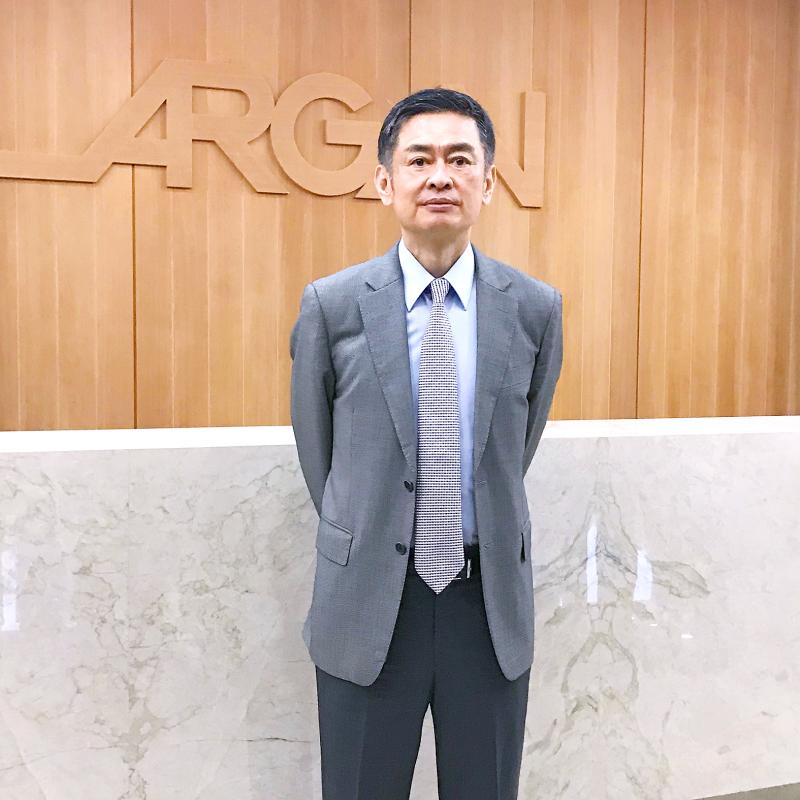Largan Precision Co (大立光), the nation’s leading camera lens manufacturer, saw its gross margin slide to 65.6 percent last quarter, from 68.6 percent a quarter earlier, after a major client canceled its orders, chief executive officer Adam Lin (林恩平) said yesterday.
“The client directly canceled all of its orders last month, which lowered our gross margin, as the client had requested high-specification orders with higher profit margin,” Lin told investors at an online earnings conference.
Lin did not name the client, while market speculation was that it was Chinese telecom equipment provider Huawei Technologies Co (華為), whose manufacturing has been disrupted by a US’ ban, demanding suppliers to stop shipping to Huawei if their products contain US technology.

Photo: Chen Mei-ying, Taipei Times
Largan has been talking with other clients to inquire if they are interested in placing more orders, but it would be “highly unlikely” that any new orders would be large enough to fill in for the allocations that were previously saved for the client, Lin said.
As a result, there is a chance that the firm’s capacity utilization rate would drop in the fourth quarter, Lin said.
The firm, which provides lenses for Apple Inc’s iPhone as well as Android phone vendors such as Samsung Electronics Co, declined to reveal how much Huawei’s orders had contributed to its previous revenue reports.
Lin expected the firm’s shipping momentum, which depends on the sales performance of its clients, to remain flat this month from last month, he said.
“Although our clients often update their forecast, there is still a high uncertainty, as it is unpredictable how their new mobile phones will sell,” Lin said.
The third-quarter gross margin of 65.6 percent was the lowest after 64.24 percent recorded in the first quarter last year, company data showed.
Largan would continue focusing on high-end lenses for premium smartphones, Lin said.
Many handset vendors increasingly favor mid-range and low-end smartphones, which has increased pressure on the firm to compete with other lens suppliers, he said.
“There is a figure for gross margin in my mind, and we will not accept orders with gross margins lower than that, although I cannot tell you how high this number is,” Lin said to investors.
Largan’s third-quarter net income plunged 30 percent year-on-year to NT$5.86 billion (US$202.31 million), due to an unfavorable product portfolio and foreign exchange losses of NT$710 million with the New Taiwan dollar strengthening against the US dollar, Lin said.
Its earnings per share were NT$43.74 in the third quarter, while in the first three quarters they totaled NT$131.
Although Largan’s stock price has dropped to a relatively low level, the company has no plan to buy back its shares, Lin said.

CHIP RACE: Three years of overbroad export controls drove foreign competitors to pursue their own AI chips, and ‘cost US taxpayers billions of dollars,’ Nvidia said China has figured out the US strategy for allowing it to buy Nvidia Corp’s H200s and is rejecting the artificial intelligence (AI) chip in favor of domestically developed semiconductors, White House AI adviser David Sacks said, citing news reports. US President Donald Trump on Monday said that he would allow shipments of Nvidia’s H200 chips to China, part of an administration effort backed by Sacks to challenge Chinese tech champions such as Huawei Technologies Co (華為) by bringing US competition to their home market. On Friday, Sacks signaled that he was uncertain about whether that approach would work. “They’re rejecting our chips,” Sacks

Taiwan’s long-term economic competitiveness will hinge not only on national champions like Taiwan Semiconductor Manufacturing Co. (TSMC, 台積電) but also on the widespread adoption of artificial intelligence (AI) and other emerging technologies, a US-based scholar has said. At a lecture in Taipei on Tuesday, Jeffrey Ding, assistant professor of political science at the George Washington University and author of "Technology and the Rise of Great Powers," argued that historical experience shows that general-purpose technologies (GPTs) — such as electricity, computers and now AI — shape long-term economic advantages through their diffusion across the broader economy. "What really matters is not who pioneers

In a high-security Shenzhen laboratory, Chinese scientists have built what Washington has spent years trying to prevent: a prototype of a machine capable of producing the cutting-edge semiconductor chips that power artificial intelligence (AI), smartphones and weapons central to Western military dominance, Reuters has learned. Completed early this year and undergoing testing, the prototype fills nearly an entire factory floor. It was built by a team of former engineers from Dutch semiconductor giant ASML who reverse-engineered the company’s extreme ultraviolet lithography (EUV) machines, according to two people with knowledge of the project. EUV machines sit at the heart of a technological Cold

TAIWAN VALUE CHAIN: Foxtron is to fully own Luxgen following the transaction and it plans to launch a new electric model, the Foxtron Bria, in Taiwan next year Yulon Motor Co (裕隆汽車) yesterday said that its board of directors approved the disposal of its electric vehicle (EV) unit, Luxgen Motor Co (納智捷汽車), to Foxtron Vehicle Technologies Co (鴻華先進) for NT$787.6 million (US$24.98 million). Foxtron, a half-half joint venture between Yulon affiliate Hua-Chuang Automobile Information Technical Center Co (華創車電) and Hon Hai Precision Industry Co (鴻海精密), expects to wrap up the deal in the first quarter of next year. Foxtron would fully own Luxgen following the transaction, including five car distributing companies, outlets and all employees. The deal is subject to the approval of the Fair Trade Commission, Foxtron said. “Foxtron will be